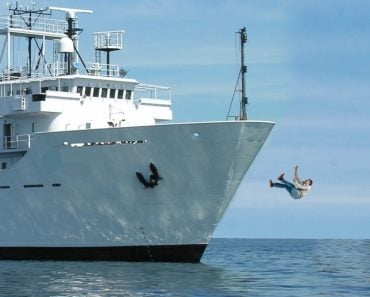Table of Contents (click to expand)
When you break the water’s surface, you will decelerate at an extremely high rate. The force exerted on your body due to the abrupt and rapid change of velocity would be too high to handle.
If you find yourself in a situation where you must jump out of an aircraft, it is important to have a parachute. However, if a parachute is not available, jumping without it should only be considered a last resort when there are no other options for escape.
If you have to jump, try to locate a large body of water, such as a sea or river, and aim your fall toward it. Even if you follow all these recommendations, the chances of survival are still uncertain.
In this article, we will investigate what happens when a person has to jump off an airplane without a parachute into a water body.
Recommended Video for you:
What Is Wreckage Riding?
Before jumping out, you should try to find a large object you can ‘ride’ during your imminent free fall. In other words, be a ‘wreckage rider’ (a term coined by Jim Hamilton, a historian who compiled an online database of every imaginable human plummet).
Your chances of surviving such a deadly plunge might improve slightly when you’re somehow padded by semi-protective debris that will absorb some of the enormous amount of energy you’ll experience when you land on the water’s surface.

Imagine this: Vesna Vulovic, an air hostess from Yugoslavia, defied all odds and survived a 10,160-meter (a little more than 10 kilometers) fall when a DC-9 exploded in mid-air. Her incredible feat earned her a place in the Guinness Book of World Records. She was wedged between a catering trolley, the body of another crew member, and the tail section of the aircraft, all of which played a crucial role in absorbing the impact energy that would have been fatal had she fallen without these protective elements.
And here’s the kicker-the first thing she asked for upon waking from her coma was a cigarette!
Terminal Velocity
Free falling from a moving aircraft cruising at a standard height will eventually cause an individual to reach their terminal velocity, i.e., the velocity at which there is no increase in the velocity of the downward motion of a free-falling body.
An average skydiver, who jumps from a height much lower than where commercial airplanes usually fly in a ‘belly-to-Earth’ position, has a terminal velocity of around 120-140 mph (54 to 58 m/s). Therefore, it’s fair to assume that that could be the minimum value of the speed you would have (depending on your mass) during the free fall.

Hitting the water’s surface at such speeds is not much different than jumping from a building and hitting the sidewalk. Although water is not as rigid as the sidewalk, it has surface tension, so water tends to stay together. This also means it exerts a force on anybody that lies on its surface.
Body’s Position Before The Impact Makes A Difference
Since we’re talking about a human (with considerable mass) falling from thousands of feet in the air, water’s reactive force upon contact would be enormous.
However, this force is influenced by mass and the cross-section of the object falling into the water. You can’t possibly change your mass during a free fall (or at any other point, really), but you can change the cross-section area of your body.
This means that you can assume a position that offers the minimum surface area of your body to bear the brunt of the huge force. You can do this by assuming a feet-first position to ensure a knife-like entry into the water or a head-down position, just like divers do.

Note that assuming these positions necessarily bumps your impact velocity as your body becomes more streamlined against air drag.
Once you break the water’s surface, you will start decelerating at an extremely high rate; in fact, the force exerted on your body due to such an abrupt and rapid change of velocity would be too much to handle. Human beings can sustain 100 G’s for short bursts of time (a race car driver named Kenny Bräck survived a racing accident in 2003 wherein a deceleration of 214 G’s was measured), but in the case of falling from a plane, it would be fairly higher than that (around 300 G’s). No human could survive that… not a regular Homo sapien, at least.

Such a huge force would cause an immense amount of internal hemorrhaging and would also throw vital organs into complete disarray, causing fatal injuries to the individual.
In general, it is safe to assume that if you jump out of an airplane into a body of water without a parachute, your chances of survival are meager.
However, if you find yourself in such a situation, keeping a few techniques in mind and trying to remain calm (as much as possible while free-falling without a parachute) may help increase your chances of survival.
Last Updated By: Ashish Tiwari













